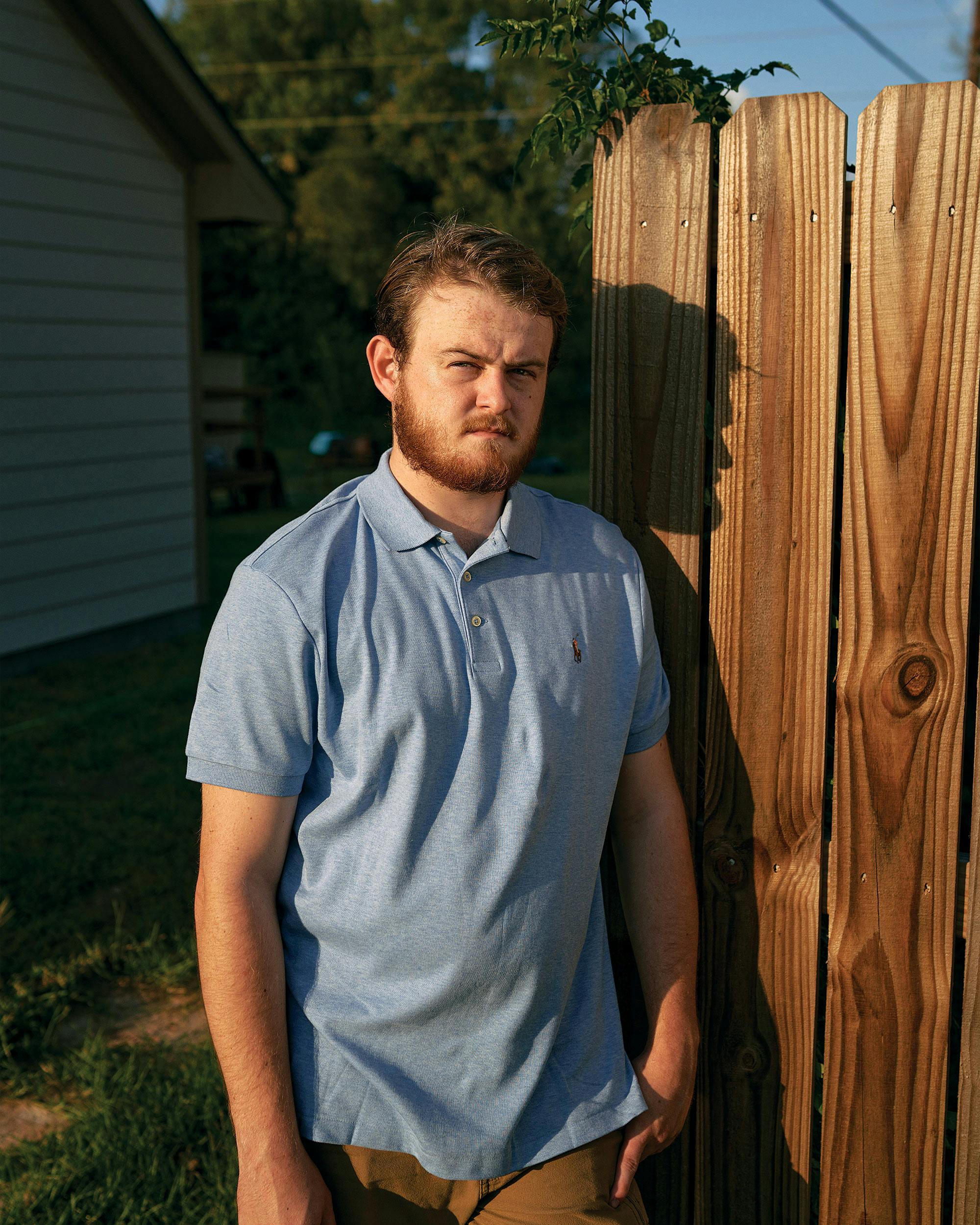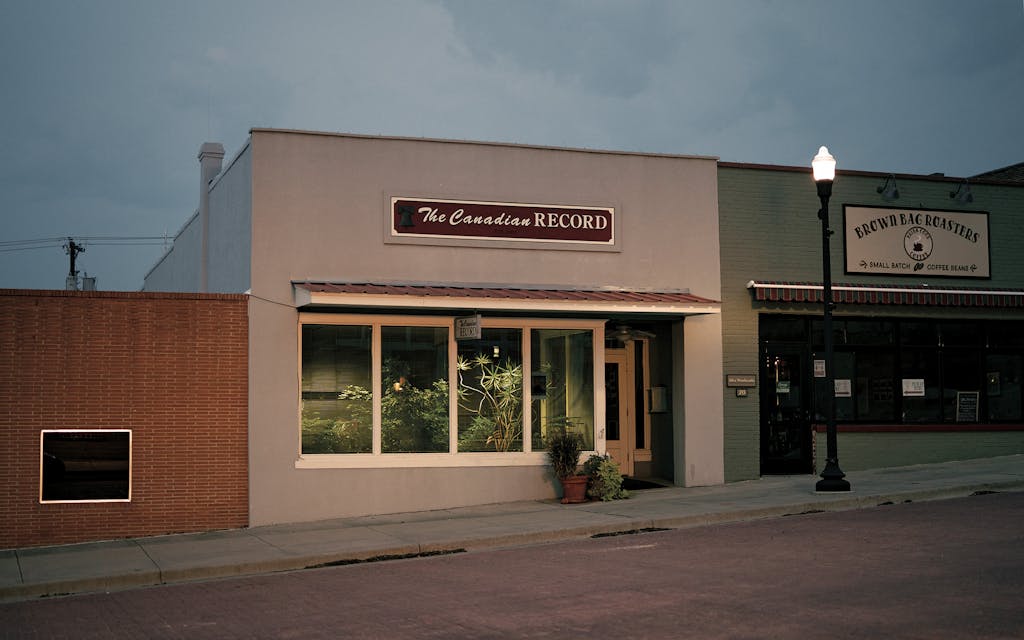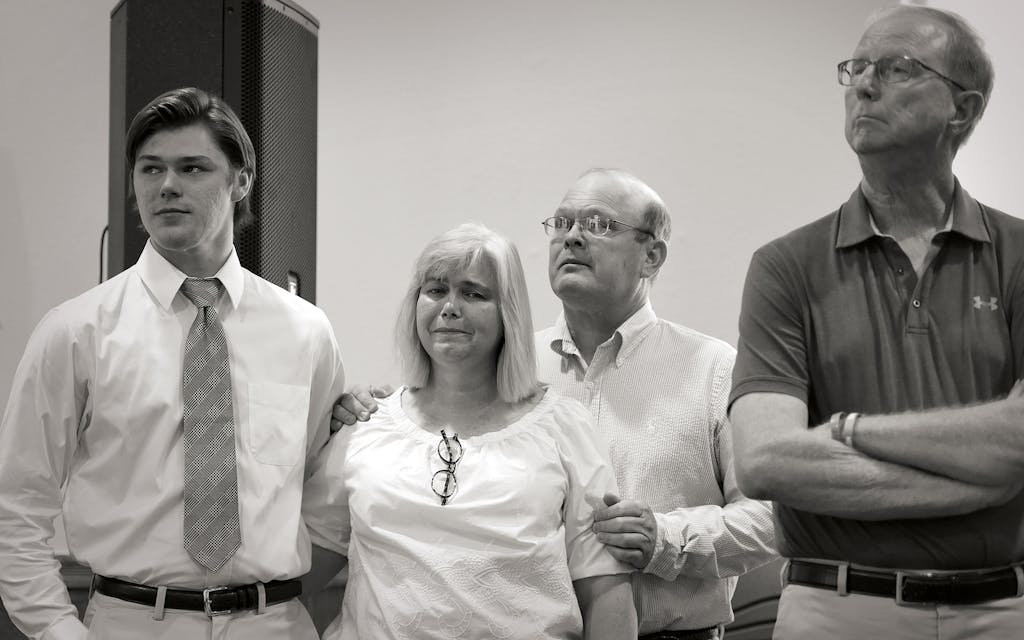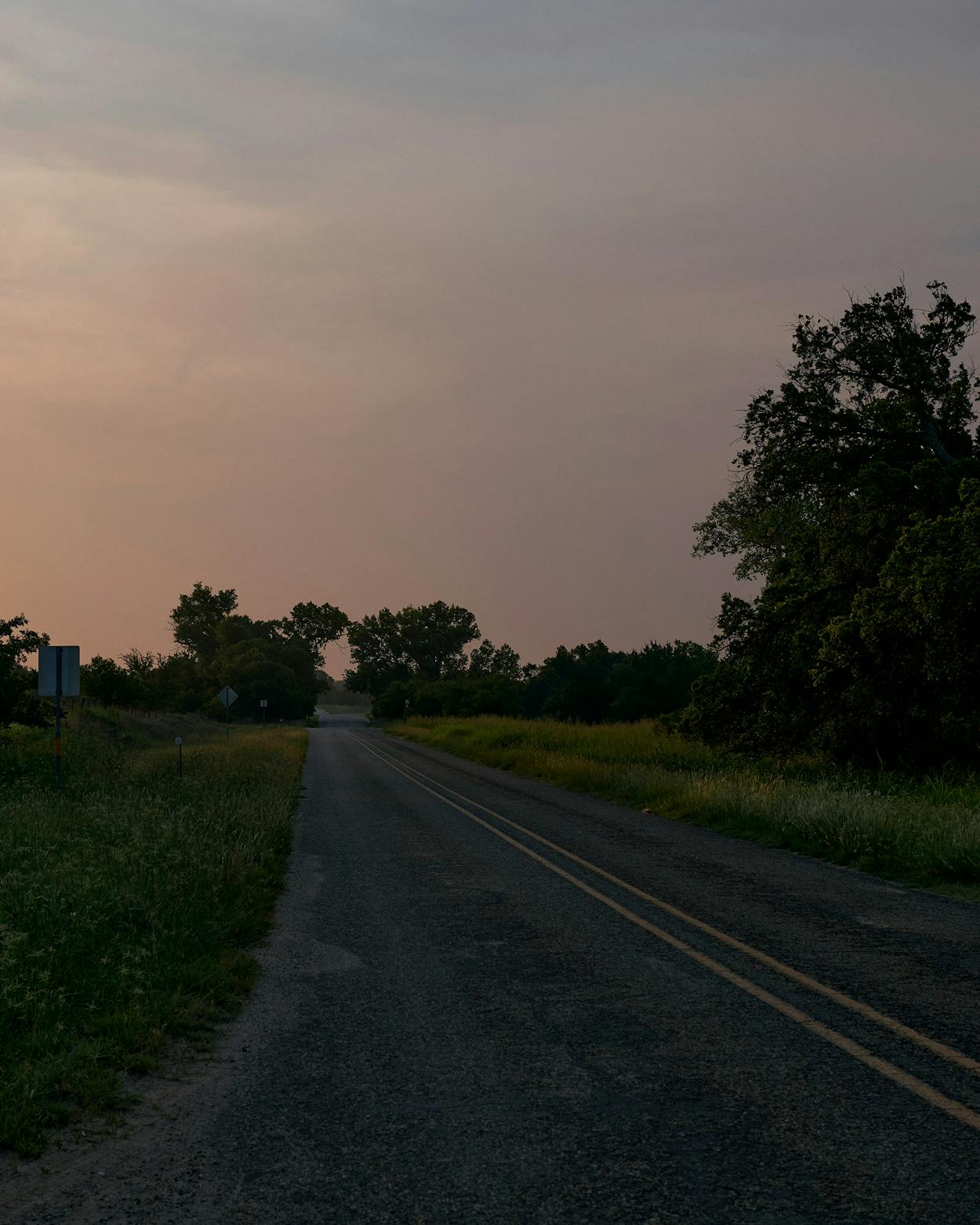Subscribe
One day in mid-January, 2017, a worker for an electric company was on a lonely farm-to-market road east of Canadian. The route is known among locals as Lake Marvin Road because it leads directly to the reservoir, fourteen miles away. The man spied something unusual: a black-and-red backpack in an upright position, four to five feet from the road, behind a barbed wire fence and under a clump of hackberry trees. He didn’t think much of it, but later, after hearing reports about the case of Tom Brown, he drove back out to the road and opened the backpack. Inside were a couple of books, some school papers with Tom’s name on them, and a school-issued laptop. He placed the bag back on the ground and headed to the sheriff’s department.
When Nathan Lewis got to the scene, the sheriff confirmed that it was Tom’s backpack. And he quickly concluded there was no way that someone could have thrown the backpack from the road and hit that spot: it would have gotten caught in the dense tangle of hackberry limbs. Someone must have intentionally placed the backpack there.
The mystery of Tom’s disappearance had just gotten a lot more mystifying. If Tom had gone straight to Lake Marvin Road after parking his Durango by the water treatment plant at 6 a.m., he would’ve had to trek through the predawn darkness for nearly four miles: traversing marshy areas; fording the thigh-high Canadian River; and making his way through acres of tall grass and heavy undergrowth. And he would’ve had to do all of that while shouldering his backpack.
It was possible that Tom had reached that spot another way. After abandoning his Durango, he could have walked back into town and over to U.S. Highway 60 (which runs right through the heart of Canadian), followed that highway north to Lake Marvin Road, then made a right turn and walked down the road to the spot where the backpack was eventually found. That trip, however, would have covered roughly eight miles. Tom only would have had an hour and a half to get there before the sun rose—and before the town started looking for him.
And there were other questions about the discarded backpack that no one seemed to be able to answer. For instance, why would Tom have chosen to tramp to Lake Marvin Road in the first place—and why would he have placed his backpack under that particular tree? Was this a sign that he had arranged for someone to pick him up? Had he then deliberately left the backpack as he rode away to start a new life?
Or, as the private investigator Philip Klein believed, was the backpack proof that Tom was the victim of foul play? Maybe someone other than Tom had placed the backpack behind the fence. Someone who had been involved in Tom’s kidnapping or killing. Someone who wanted to dispose of evidence.
Klein decided it was time to introduce himself to the Panhandle. He made multiple appearances on Chris Samples’s popular radio show, and true to form, he mesmerized listeners. At one point, he took a veiled shot at Sheriff Lewis by telling the audience that something terrible must have happened to Tom. “We believe at this point in time that we have no credible evidence that Tom Brown is a runaway,” he said. “We have completely vetted the opportunities for Mr. Brown to run, and we just don’t see it based upon the evidence that we have at this time. If he did leave the area, he left the area with no money, the clothes on his back, no car, no means or the ability to garner any money other than go somewhere and get a job.”
During one of his interviews with Samples, Klein dropped a bombshell of his own. “We do believe that we have established some possible suspects in the city regarding some possible nefarious activities, and we’re exploring those,” said. He also implored any Canadian high student who knew what had happened to Tom to do the right thing and come forward. “You know something, you need to say something, because at this point, if this case continues to go in the direction it is, then you could be charged with a crime for withholding information,” Klein announced.
No one came forward. But public interest in Tom’s case continued to soar, in large part because Klein continued to insist that Tom was the victim of a crime. In April, word got around that Klein had brought in Trace Sargent, a respected dog handler from Georgia. Sargent is especially well-known in law enforcement circles for her cadaver dog, a Lab mix named Chance who had been trained to track down human remains. While residents watched curiously from their front porches, Chance trotted up and down Canadian’s streets. He sniffed around the parking lot and bleachers at the football stadium. He nosed around the part of Lake Marvin Road where the backpack had been found. And he was taken to Tom’s Durango, which by then was back at Penny’s home, parked in the driveway. Chance circled the SUV. He sniffed the streak of blood on the driver’s door. (Law enforcement technicians had determined that the blood on the door had come from Tom.) According to Klein, the dog sat down, which supposedly meant he’d hit a cadaver scent.
“The smell of death was in the car,” Klein told me, lowering his voice to a whisper.

But Chance didn’t produce any promising leads. And in the absence of credible evidence, new rumors surfaced about the teenagers who supposedly were being investigated by Klein.
Several Canadian residents accused Michael Caseltine of being one of Klein’s “possible suspects.” Michael had gone cruising with Tom early on Thanksgiving eve. He also smoked pot and occasionally sold marijuana to other students at Canadian High, a fact he openly admitted to Sheriff Lewis and his deputies when they first interviewed him. But he said he never smoked weed with Tom. According to Michael, Tom hated drugs.
Michael also insisted that he was home on Thanksgiving eve by around 8 p.m., an alibi backed up by his mother, Shannon, an artist who runs a small yoga studio in Canadian and sells homemade protein bars on the side. Shannon told me that she had stayed up late that night painting, and she had just drifted off around 2 a.m. when Michael came out of his bedroom. He told her that he’d just gotten a phone call about Tom and that he was going to look for him. Michael was gone for only about an hour, not enough time to do anything sinister, Shannon said.
But that didn’t slow the speculation. When I asked Michael about the rumors, he was emphatic. “I’ll let the truth speak for itself,” he said. “There’s absolutely nothing that points that I had anything to do with this in any way, shape, or form.”
And the accusations didn’t end there. Some Canadian residents claimed that another of Klein’s teenage suspects was Chris Jones, a running back on the football team that season. In December 2016, a month after Tom disappeared, Chris was arrested on a misdemeanor assault charge for fracturing the orbital socket of a fellow student’s right eye. (Chris pleaded guilty and later served one hundred days in the county jail after violating his probation.) Klein was indeed curious about Chris. Klein asked his daughter, Caroline Gear, who worked for him as an investigator, to get Chris on the phone.
That fall, Chris had been living with a family friend in Canadian, until the friend moved to New Mexico. Then Chris had gone to live with the school’s head football coach. He told Caroline that on Thanksgiving eve he had gone to bed around 10 p.m. at the coach’s home.
“Have you had any other interactions with anyone that has any information on Tom’s whereabouts?” Caroline asked.
“No, ma’am,” said Chris.
“Okay, do you think he’s alive?”
“I don’t know what to think,” Chris said. “I don’t want to think a kid I played football with, one of my friends, is dead. So I don’t think about it like that. I want him to be okay, so I’m going to think he’s okay.”

The Canadian Record’s Laurie Brown did her best to keep up with the onslaught of gossip, trying to parse out the few facts from the seemingly endless theories. But it was impossible. Everyone in town seemed to have a “hunch” as to what had happened. At Canadian’s cafes and restaurants, residents spent hours swapping thirdhand information over cups of coffee and plates of chicken-fried steak. When anonymous donors added to the Toot ’n Totum reward fund, raising it first from $5,000 to $12,500 and then eventually to $40,000, the rumors got crazier. Someone informed the sheriff’s department that Tom had been injected with acid by members of a drug cartel. Someone else sent a letter to the sheriff’s department, written in block print with no signature, claiming that Tom had been murdered and buried in a chicken coop by a married couple who were meth dealers and money launderers for a motorcycle gang. Apparently, Tom had discovered what the couple was up to, and they had decided to shut him up.
At the same time, reports of more Tom Brown “sightings” continued to flood the sheriff’s department. An optician in Kansas called to say that a young man who could have been Tom had walked into her office; he was accompanied by an older man and asked to get his glasses fixed. Another man swore he saw Tom eating quesadillas with an older couple at a restaurant in Anthem, Arizona. Of course, none of the tips panned out.
“I just want Thomas to come home and that’s it. It doesn’t matter who’s involved. I just want him to come home.”
Sheriff Lewis blamed much of the gossip-mongering on Klein and his unfounded claims about teenage suspects. Lewis decided to go back on Chris Samples’s radio show to kick Klein down a notch or two. “Sheriff,” Samples said, “Mr. Klein with Klein Investigations had previously noted that not only did he think foul play was involved, but that someone at Canadian High School . . . had direct knowledge of what happened. Can you verify, is there any proof that anyone at Canadian High School, a student, had any personal knowledge of what has happened to Thomas Brown?”
“Chris, I can’t. There’s just absolutely no evidence,” Lewis replied. “We don’t have any evidence laying out in front of us saying that an assault or homicide occurred.” Lewis went on to say that there was no credible information supporting Klein’s theory that someone other than Tom Brown was driving the Durango at any time during the night of Thanksgiving eve, that the driver had walked back into town after parking the Durango by the water treatment plant, or that the backpack was deliberately planted by Tom’s killer on Lake Marvin Road.
What Lewis didn’t mention on the air was that his fellow lawmen with the Texas Rangers and the FBI had developed their own teenage suspect—not someone they believed to have hurt Tom, but someone who might’ve helped him disappear.

Christian Webb could sense she was being watched. It was the morning of April 11, 2017, and as she walked to her first class of the day at Oklahoma State, she spotted a black Suburban that seemed to be trailing her.
Later, as she walked out of her biology class, she noticed a man in a suit. He was obviously waiting for her. He introduced himself as a university police official, and he asked Christian to come with him. “And he said, ‘I’m guessing that you know what this is about,’ ” recalled Christian. “And I said, ‘Yes, sir.’ ”
He escorted her to the Suburban, drove her to the university’s police department, and led her to an interrogation room, where a Texas Ranger, Mike Smith, and an FBI agent, Scott Hendricks, were waiting. The university officer left and closed the door behind him. Christian soon began shaking.
As part of their investigation into Tom’s disappearance, the officers had obtained Christian’s cellphone records. They revealed that between December 31, 2016, and April 6, 2017, she had exchanged numerous texts with someone using a mobile phone registered to a teenager in Denver, Colorado, named Nathan McGwier. Nathan happened to be close to one of Christian’s best friends, Macy Patterson, who had graduated from Canadian High and moved to Denver to attend art school. (Early in the investigation into Tom’s disappearance, Macy was the one who had told sheriff’s deputies that she and Tom had once talked about sneaking out of Canadian without being traced.) Christian said Macy had introduced her to Nathan and the two had hit it off.
The law enforcement officers, however, wondered if Christian had helped Tom get out of Canadian and if he was now using Nathan’s cellphone to stay in touch with Christian.
Christian told the officers that none of that was true, and she willingly gave the Ranger and FBI agent her phone so they could look through it. “I was totally fine because I had nothing to hide,” she said. At their request, she jotted down everything she could remember about the night Tom went missing. She then was interrogated for four hours. Christian said they accused her of knowing where Tom was hiding. “They kept probing and probing,” said Christian. “They told me that I was not telling the entire truth. And I kept saying, ‘That’s all I knew.’ ”
Christian said she eventually started crying and felt nauseated. When they asked if she would submit to a lie detector test, she readily agreed. But instead the officers just left.
The next day, Christian called her parents, Trey and Anita, to tell them what happened, but she didn’t talk for very long. She told them she was paranoid her phone was bugged.
That night, Trey and Anita went to dinner at the Bucket, one of Canadian’s home-style restaurants. Sheriff Lewis happened to show up with his family. According to Anita, Lewis apologized for Christian’s interrogation, but he told them that their daughter had been completely cleared of criminal activity. “He said, ‘We know that Thomas has run off with an older man to Colorado,’ ” Anita recalled. “ ‘He’s somewhere in Colorado with an older man.’ Those were the exact words out of his mouth.”
Lewis denied ever suggesting that Tom was with an older man or that he’d run off to Colorado. Meanwhile, the Texas Rangers and FBI set their sights on another Canadian teenager. This time, they asked Kaleb King, the state representative’s son who also had spent time with Tom on Thanksgiving eve, to meet them at the sheriff’s department.
“They hit me over and over, saying, ‘Do you know where Tom is? Have you seen Tom since this has happened? Have you been in contact with him in some way since this has happened?’ ” Kaleb recalled. “I said, ‘No, I have not seen Tom since November 23, 2016.’ ”
But nothing seemed to placate them, Kaleb said. “And they’re like, ‘Well, we don’t believe you. We don’t. If we find something, we’re coming for you. You’re done.’ And I’m sitting there thinking, ‘Oh God, I’m so scared right now.’ I couldn’t convince them. And so I just let them hammer me.”

In the eight months following Tom’s disappearance, Tom’s mom Penny Meek had only been quoted a few times by Laurie Brown for her articles in the Canadian Record. But in July of 2017, as it became clear that the sheriff’s investigation had stalled, Penny decided to hold a press conference in the youth room at the Methodist church. Accompanied by her husband and by Tom’s father and brother, Penny stood at a podium before a standing-room-only crowd of Panhandle-area reporters and curious Canadian citizens.
She began by assuring everyone that Tom was not, as rumor had it, a troubled teen. “No evidence has surfaced suggesting that Thomas led some alternative life we knew nothing about or perhaps was suicidal,” she said. She added that it didn’t make sense that Tom would just impulsively run away. “Thomas and I were very close. I think everyone would agree that he’s kind of been a mama’s boy since he was born.”
And blinking back tears, she declared that she still hoped to someday see her youngest son again. “I just want Thomas to come home and that’s it. It doesn’t matter who’s involved. I just want him to come home.”
But that wasn’t the actual reason Penny had called the press conference. She announced that she had lost faith in the sheriff’s department’s investigation. “I am grateful for all the work done by our sheriff’s office, but I believe there were some assumptions made in the very beginning, which weren’t based on facts and ultimately led to doing nothing,” Penny said. “We are beyond frustrated with the lack of new evidence or leads garnered. Navigating the various law enforcement agencies has proven to confuse us, frustrate us, and leave us questioning much about the way the investigation began and has continued. We need answers.”
Sheriff Lewis happened to be at the press conference, standing in the back of the room. He was caught completely off guard. Everyone turned to look at him, and he made his way to the podium. He told the crowd that he and his staff, along with the Texas Rangers and the FBI, were still working diligently on the case. “We have not forgotten Tom Brown,” he said. “We will not forget Tom Brown. We will do everything in our power to find Tom Brown, and we have not given up, nor will we.”
Yet Lewis was not ready to say, at least publicly, that Tom was a victim of foul play. “Right now, we have no evidence to say that anything else has happened. We have no evidence showing that a crime has been committed. And so at this point, he is missing.”
Klein was not at the press conference—he was at his office in Nederland—but that didn’t stop him from entering the fray. He went back on Chris Samples’s show to tell the Panhandle his latest theories on how Tom had been murdered. He said that he believed Tom’s final cellphone pings on Thanksgiving eve placed him near the high school football stadium around midnight. And it was most likely there, Klein said, that something happened that led to Tom’s death.
“We think it probably wasn’t a premeditated situation,” Klein told Samples. “It was probably a situation where something happened. He ran into some friends or he ran into some frenemies or some enemies. And then it was a situation that got out of control. Maybe it was a simple little fight between two people and one punch landed a death blow and then they had to cover it up,” said Klein. “And without going into the evidence, I will say we have about three persons of interest that we are focusing on. We’re trying to talk to these three young people and say, ‘Look, just tell us what happened. Just give us the information and tell us where he is.’ ”
Although Klein offered no hints about the identities of his three teenage “persons of interest,” he did claim that he had received a tip that possibly “will lead us in the right direction in this case.”
In fact, he told Samples, he was organizing a major search in the Canadian area. He declined to specify where the search would take place, and he wouldn’t provide any details on the evidence he would be looking for. But what little he did say got the Canadian gossip mill churning once again. Word got around that Klein had acquired vital new information.
And that he was about to crack the case wide open.
Read Chapter 5: Unusual Suspects
Chapter 1: A Pretty Little Place
Chapter 3: “Evil Has Come to Canadian, Texas”
This article originally appeared in the October 2020 issue of Texas Monthly with the headline “Tom Brown’s Body.” Subscribe today.









